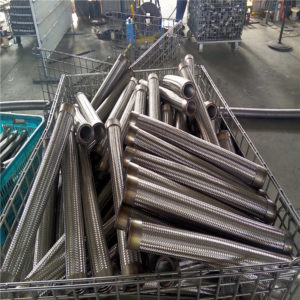Any product has a useful life and shelf life. The same is true for stainless steel metal hose joints. After long-term wear and tear, leakage may occur. If effective measures are not taken to remedy in time, it will cause series production and safety problems. As a professional manufacturer of metal hoses, I will introduce the countermeasures when metal hoses leak.
 1.Replace the metal hoses of the outlets of all synthetic water tanks;
1.Replace the metal hoses of the outlets of all synthetic water tanks;
2. Replace all parts materials that have been in contact with the medium, including flanges, metal joints, etc .;
3. Before adjusting the installation position of the original gate valve on the tank to the metal hose, if there is a problem with the metal hose, the valve can be cut off to avoid a large amount of leakage of the medium in the tank; meanwhile, even if the metal hose connector leaks again, it is easy to replace it quickly. To minimize the impact on production and safety.
Precautions to avoid leakage of metal hose joints:

In order for the metal hose to function properly during use, in addition to timely taking remedial measures when a leak is found, it is necessary to strengthen preventive measures before this to avoid leakage as much as possible. Here is a brief introduction.
1. Designers need to understand the condition of the medium flowing through the metal hose before the selection, including the composition and corrosivity of the medium, correctly select the component materials of the overcurrent part, and propose the corresponding technical requirements to avoid galvanic corrosion.
2. After being put into use, the inspection of metal hose joints in important parts should be strengthened, and the changes in the process medium should be closely monitored. Once the changes in the process medium indicators related to corrosion, such as increase in conductivity and decrease in pH, etc., it should be confirmed in time. Whether metal hoses and joints can meet existing process requirements and take necessary precautions in a timely manner.
